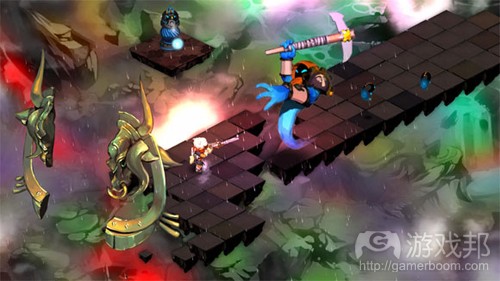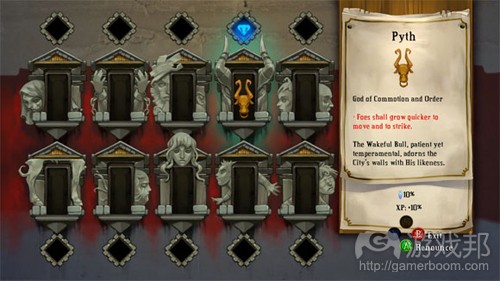《Bastion》是如何将叙事与玩法完美融合?
作者:Andrei Filote
叙事与电子游戏总是紧紧相扣。即使《Pong》这种简单游戏也会通过某种方式展现故事,比如玩家基于画面内容创建自己的体验。通常游戏中的故事是通过玩家与之互动产生,但甚至在这种媒介诞生数十年的时间后,我们仍旧无法确定制作互动式叙事风格的最佳方式。
数十年来,相关学者与设计师已经就此方面进行了详尽探讨,但现在,我们有必要看看那些能够体现玩法与叙事完美结合(个人观点)的典范。
电子游戏是如何催生出故事?其实这得归结为大脑消化信息的方式。根据我们处理视觉信息的方式,图像会自动转变为叙事模式。许多游戏均按此方式呈现故事,因为同电影一样,游戏也指一系列按一定顺序发展的图片。重点是,我们常把叙事、对话、故事与玩法隔开,但事实上,它们如同硬币的两面,紧密相连,相互依存。由于电子游戏的背景是个虚拟环境,因此我们对该环境与其中事件的认知会自动形成故事。
如今,许多游戏一方面让玩家经历事先安排好的故事情节,另一方面则通过他们与虚拟环境的一系列互动,自然而然地引申出更多故事。但总存在一系列限制条件(无论是技术上,还是哲学上)隔离这两方面,因此我们常以交替方式进行体验。这也引出一些问题:我们从未在游戏中设置适当的故事情节;而在玩法或过场动画中产生的故事则与游戏毫无关联。因此,整个体验形成一种断裂模式:一部分是游戏,另一部分则是游戏中包含的电影。
尽管存在这些常见问题,但仍有些游戏致力于解决非互动式过场动画的约束条件。其中一例便是最新作品《Bastion》。
互动式故事:三个方面
以下三个事例均强调了提示信息的用法,这是一种尤其适合电子游戏但却总被忽略的技术。在游戏这种重视爆炸性元素的媒介中使用如此低调的元素,似乎是一个愚蠢做法,但电子游戏对关注度的需求本性,却正是提示信息能够发挥作用的重要原因。当你正陷入一场苦战时,突然呈现的一些截然不同的内容,或许有可能创造一种长远动机,为一些明显的操作行为提供全新的情境。
1.暴力折射叙事
通常,暴力是游戏的导火索,但当用户在消灭对手上倾尽大部分时间后,战斗将变得无关紧要,故事情节也失去本身意义。《Bastion》提示的潜在信息则改变了这一情况。
首先是游戏中存在的大量武器。武器科技的不断提升透露出Caelondia社会日益突显的战争。与此同时,我们也见识到了一个需要层次:创建(锤子),对抗环境(矛、弓),控制环境(火箱),对抗其它社会(卡宾枪、步枪),完全主宰那些社会(迫击炮、破坏性炮弹),解锁终极武器(摧毁)。
游戏进程紧随故事与主题发展。随着武器具有更大破坏力,你越发认识到,由试图主宰自然的殖民者成立的City,与仍生活在不受侵犯神圣领地的Ura创立的社会之间存在种种冲突。
显然,这是一段社会暴行的简史。随着殖民者开拓新大陆,他们会销售锤子,换取弓箭、步枪、大炮。Calamity割裂山脉,摧毁生物的能力其实是种超现实的核武器。同时也是武器中的极端,并且是人们不会打败战的终极保障。游戏发生于Calamity的背景之下,如果要扭转局势 ,Kid除了与现实妥协之外,别无选择。他想逃脱的同时,也在为其所困。
2.情境化的敌人
你在游戏中面对的敌人既不是无名氏,也不会毫无作战动机。在Calamity发生之前,它们扮演着不同角色,现在则开始重塑身份。根据叙事者的说法,它们会与Kid发生冲突,后者的目标是重建Bastion,争取全面胜利。无论叙事者的措辞是否可信,但这并不能构成屠杀那些只是试图建立自己的安乐天堂的无辜物种的理由。
游戏让你意识到,敌人拥有与自己同等的生存权利,这是该游戏的一个关键部分。这些敌人也是目前Kid最显眼的反对势力,它们挣扎在组织、重组与重建的过程中,试图建立一个劫后重生的世界。这明显是一个有得有失的过程。比如Windbags本来是种较低的社会阶层,现在则无家可归迁移至一个荒废城市;Ura幸存者将悲痛转化为复仇力量,但从未忘记尊严;Peckers则在灾难后充满了优越感,他的愤怒方式十分有趣。人人都会按照自己的动机清晰行事,而且乐意利用自个资源完成目标。它们的做法仅仅是折射出Kid的行动,并且与之一样充满决心。
Bastion中的对手本质并不恶劣。它们也不会盲目接受厄运。大多数时候,它们属于自然世界,或社会的一小部分,或是一个完全不同的社会。可是,它们均遭遇侵略者(你)的暴行。这是一个了不起的成就,因为《Bastion》并不只是简单地涌现众多敌人让玩家扫射,它也阐述了敌人的立场,这一点让游戏蕴含更多深意。
3.神殿
神殿概念完美结合了两种需求:一是用于解释Caelondian人的信仰,二是发挥增加游戏难度的功能。而这些用途则通过祈祷来实现。祷告本身存在两个层面。首先是界面上,借此玩家能够知晓自己陷入的麻烦(游戏邦注:比如敌人的攻击加快加强等)。但故事模式不存在界面,从Kid角度看也不存在所谓的用户:他的祈祷行为纯粹是种信仰,如同摇摆锤子只是种习惯。他决定进入未知世界,进行相关探索。
他想要什么?我们不得而知。我们只知道自己会面临困境、考验与磨难,这些都是惩罚形式。现在猜测Kid会因过去行径遭遇惩罚是否为时过早?我们只能疑惑,但疑惑本身就是奖励与成就——我们已经构造出拥有自己生活与体验的角色,它们同我们一样存活于每时每刻,就好像它们已经自成一体,存在于只有我们有权接触的时空。而这正是所有叙事内容的目标,无论是游戏、电影或小说。
我们只有通过提示信息才能感受到这一点,我们很容易忽略这些静谧和轻声诉说的内容,但它们却为我们留下了无限的想象空间。由此我们可窥见其美丽的外表下,多彩的世界背后,玩家所触及的壮丽物质世界之外的深层意义——《Bastion》是一款关于种族冲突,甚至是种族灭绝,以及关于人类种种错误的游戏。
特殊元素:叙述者
不少电子游戏均采用叙述者支持故事情节的发展,但《Bastion》中的叙述者却显得十分独特,它贯穿故事始终,并且会回应玩家的行动。
由于《Bastion》的叙述者会根据玩家动作做出相关反应,因此Supergiant Games开发团队需要确保他的每句台词均吻合游戏情境,玩家的动作氛围以及游戏叙事内容。因为稍微一丁点儿偏差,或某个错误步调,便会致使这位忧郁严肃的叙述者陷入滑稽境地。但《Bastion》并没有犯下这种过失,其叙述者努力配合脚本情节与玩家自然催生的故事。
虽然在与玩家配合上耗费了大量时间,但该作的叙事内容不仅限于描述玩家的行动。玩家在整个游戏过程中,不仅能够获得清楚的阐述内容,还会发现自己与叙述者的配合更为紧密,因为后者的每句台词均透露出他自己与游戏世界浑然一体的感觉。
同时,我们很容易发现这整个设置是开发者精心构造而成,它除了营销推广之外并无其他有趣用途。我们可以想象这个系统的多种不同形式,甚至是一个允许玩家停用整个叙事模式的系统。但《Bastion》并不能这样做。如果根除该作的叙述者,这便是削弱游戏的主心骨,移除了游戏中的所有有意义的行动。这并不是与其他系统(例如武器、升级等)平行的系统,而是承载整个故事叙事框架的系统,它是《Bastion》体验的核心。
同神殿一样,叙述者的作用也具有多种层面。他可以在游戏进程中为我们揭示游戏世界的情况,但他并不是无所不知的全能者,仅仅是利用自己获知的某些信息提示玩家,时而回忆,时而揣摩与猜测,有时候甚至是一无所知。例如在游戏最后阶段,他在游戏叙事框架中只告知我们要去取悦两个人物,而我们最终与无时不刻相伴左右的叙述者面对面时才得知情况,才知道只有采取这一行动才能等到游戏的“结局”。
而在游戏尾声,一切都已发生改变。玩家在通关后无法回头。有些事情已经永远逝去,这不仅包括选择的权利,还有其中的幻觉。其故事清楚表明,强大的记忆和推测能力有助于玩家方便快捷地重建家园。我们从能够简单修饰的过去,进入了未知的现在。我们抵达了故事源头、结局与Bastion的核心部分。接着,故事终结,叙述者褪尽神性,真实世界迎面而来。(本文为游戏邦/gamerboom.com编译,拒绝任何不保留版权的转载,如需转载请联系:游戏邦)
How Bastion Blends Narrative With Play
by Andrei Filote
[Many games support their narratives via cutscenes and other non-interactive channels, but Supergiant Games' Bastion finds a way to work storytelling into its very core.]
Narratives and video games have always gone hand-in-hand. Even simple games like Pong find a way to tell their own stories, as players create their own experiences based on what’s happening on screen. Stories in games often emerge from the way we interact with them, but even decades after the medium’s inception, we still don’t have a solid consensus on the best ways to craft interactive narratives.
An exhaustive discussion of these methods will likely entertain scholars and designers for decades to come, but for now, it’s worth taking a look at a few examples that in my mind demonstrate a seamless union of gameplay and narrative.
How does narrative come about in a videogame? In essence, it all comes down to the way the brain assimilates information. Based on the way we process visual information, images lead automatically to narratives. This is convenient for games because — like movies — they are all pictures strung together in sequence! It’s important to note because that we often separate writing, dialog or story from play, but in reality they are as tightly interdependent as the two sides of a single coin. Since a videogame exists as a virtual environment, our perception of that environment and of what takes place within it automatically creates a story.
Many games today try to get the player to experience a written, pre-defined story on one hand, and on the other a series of interactions with the virtual environment, which create other, more spontaneous stories. Usually these two halves are kept separate by a series of constraints, whether technological or philosophical, so that we often experience them alternately (one section of gameplay leads into a corresponding cutscene and so forth). This creates a bit of a problem: proper storytelling is never addressed; as the stories that emerge during gameplay or cutscenes have little or nothing to do with each other. Thus, the whole experience becomes divided: One part is a game, the other is a movie contained within the game.
But despite this common problem, there are games that have found ways to work around the constraints of non-interactive cutscenes. One of the latest is Bastion.
Interactive Storytelling: Three Examples
The three instances we will be looking at are all underlined by the use of suggestion, a technique which is supremely suited to videogames but often ignored. It seems almost foolish to make use of something so understated in a medium that has a tendency to celebrate explosions, but the attention-demanding nature of videogames actually lends itself very well to suggestion.
While you are distracted with the challenges of the moment, something entirely different may unfold beneath the fabric of the immediate, creating ulterior motivation and providing new context to otherwise obvious actions.
1. When violence mirrors narrative
Violence is often a vehicle for play, but when the user spends most of his or her time physically destroying opponents, combat tends to become trivial, and it tends to lose significance in terms of storytelling. The critical subtext provided by Bastion’s use of suggestion changes all of this.
Consider first the game’s array of weapons. The progression in their technological advancement reveals the increasingly warlike aspect of the society of Caelondia. We witness a hierarchy of needs: to build (the hammer), to defend oneself from the environment (spear, bow), to dominate the environment (fire bellows), to combat other societies (carbine, musket), to dominate those societies completely (mortar, calamity cannon), to unleash the end-all weapon itself — the Calamity.
The progression follows the development of the story and its themes. The more destructive your weapons become, the closer you get to learning the truth about the equally destructive conflict between the City, founded by colonists who seek to exploit nature and harness its forces, and the Ura, who still live in a world of inviolate divinity.
It’s a remarkably simple history of a society’s violent deeds. As the colonists penetrate the new continent, they trade hammer for bow for musket for cannon. The Calamity, with its ability to sunder mountains and render any living being into ash, is a surreal nuclear weapon. It is also the logical extreme of the arms race and at the same time the ultimate guarantee against defeat. It’s fitting that the game take place in the backdrop of the Calamity, because in attempting to reverse it the Kid has no choice but to come to terms with the reality of its deployment. Having just escaped it, he is embraced by it.
2. Contextualizing the enemy
Your enemies are neither anonymous nor without motivation. They occupied different roles before the Calamity and must now scramble to rebuild themselves. Their efforts come into conflict with the Kid’s, whose goal of rebuilding the Bastion is, according to the narrator, a victory for everyone. Whether we can trust the narrator is one thing, but this justification suddenly provides a sharp counterpoint to the killing of the sentient creatures who are attempting to create their own version of a safe haven.
The realization that your enemies have as much right to survive as you is a critical part of the game and is present most obviously in their opposition to the Kid, in their struggle to organize, regroup and rebuild, looking clearly to path out a future in a world which must recover from apocalypse. These are clearly the efforts of someone who has something to gain and to lose. The Windbags, a lower social order now displaced but inheriting a ruined city; the Ura, whose survivors focus their grief into vengeance, though not so much as to forget honor; the Peckers — birds with a “post-calamity superiority complex” — who are a humorous if irritating addition. Each are clearly acting on their own motivations, and are willing to use their resources to accomplish their goals. In so doing they are simply mirroring the Kid’s actions, and are being just as definite, as resolute.
Bastion’s antagonists are not evil. Nor do they rush blindly to their doom. Most of the time they are the natural world, or the lesser part of society, or a different society altogether.
They are all, undeservedly, subject to the violence of an invader: You. It is important to spell out this achievement, because Bastion doesn’t simply spill out hordes of automatons for the player to gun down. It provides context for its antagonists, which helps the game become something more.
3. The Shrine
The Shrine as a concept executes a perfect marriage between two separate needs: one, strictly narratological, to explain the faith of the Caelondian people, the other, a function of gameplay, to enable higher difficulties. Both of these are achieved through the act of praying. Prayer itself exists on two levels. The first level is that of the interface, which tells us, the player, who we are invoking and what we are getting for our trouble (enemies hit harder, faster, etc). But in the story proper there is no interface, and from the Kid’s perspective there is no user: His prayer is an act of pure faith, and like swinging his hammer, it’s no make believe. He makes a decision, reaching out into the unknowable to ask for something.
What does he ask for? We never know. What we get is difficulty, trials, and tribulations, all of which constitute one thing: Punishment. Is it too far a leap to guess the Kid believes he deserves to be punished for the crimes of the past? We can only wonder, but wondering is in itself both reward and achievement — to have created characters who own their lives and act on their experiences, who, in short, live every moment as intensely as we do, as though they have broken away and now live independently, occupying a space we have the privilege to touch. That is the goal of any narrative, whether it comes in a game, film or novel.
These considerations can only be made through the use of suggestion, through those silences and whispers which tell us enough to get by, but which conceal an entire world left to the imagination. Beneath the surface of its beauty, behind the lush color palette, beyond even the physical world which comes together spectacularly at the player’s feet, Bastion is a game of ethnic conflict, even of genocide, and of many, many mistakes.
An exceptional element: The narrator
Plenty of video games have used narrators to support their storylines, but there has never been one quite like Bastion’s, which is all-encompassing, and reactive to the player’s actions.
Because Bastion’s narrator reacts dynamically based on the players actions, the development team at Supergiant Games needed to make sure that each of his lines fit the context of the situation, matched the tone of the player’s actions, and even fit within the game’s narrative. With even a slight deviation, a single false step, the grave, melancholy Narrator could have turned into a hilarious accident. But Bastion made no such mistake, and its narrator manages to encompass both scripted plot and a player’s naturally arising story.
While it spends much of its time reacting to the player, Bastion’s narrative goes far beyond just describing his or her actions. As players work their way through the game, we not only receive clever exposition, but find ourselves in a position better and better suited to judging the narrator himself, who with every spoken line reveals as much about his own person as about the world.
It’s also easy to see how the entire device could be construed as a gimmick, a peripheral part of the whole exercising an interest useful for little else but marketing. We could envision many different forms of this system, even one in which the player might be able to deactivate the narration entirely. But that’s not the case here. To uproot the narrator would be to cripple the game’s very spine, removing in one violent pull any and all meaningful motion. We are not dealing with a system parallel to others (weapons, upgrades, etc) but are facing up to the carrying structure of the whole narrative. It is the essential core of Bastion’s experience.
Like the Shrine, the narrator works on multiple levels. He reveals to us the world as we advance through it, but he is not omniscient, merely working with information he has managed to acquire retroactively, sometimes conjecturing, sometimes just guessing, other times becoming defensive or proving to be simply clueless. There are times, such as during the endgame, when he works openly within the greater frame of the story being told to entertain two people simply waiting for the” End,” though we do not realize this fact until we have come face to face with the here and now of the narrator, which has always been the player’s destination.
The endgame is where everything changes. Players pass the point of no return. Something is lost forever, and not just the possibility of choice, but the illusion of it. The story is revealed to be precisely that, a convenient reconstruction drawn out of memory and guesswork. Where we have been working from the easily decorated past we have come into the uncertain present. We reach what is simultaneously the source of the story, and the end of it all, the heart of the Bastion. The narration then ceases, ridding the speaker of his divinity, and we come into the full force of the immediately real. Then it’s time to make a choice. (source:gamecareerguide)











































 闽公网安备35020302001549号
闽公网安备35020302001549号